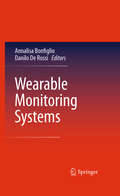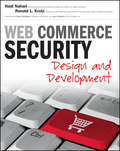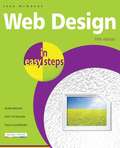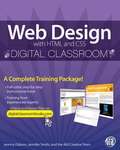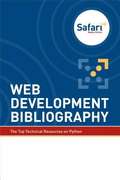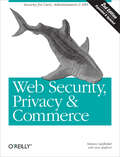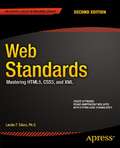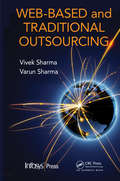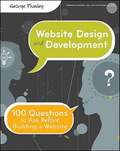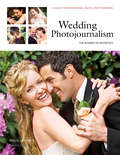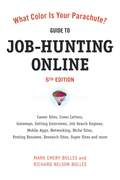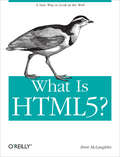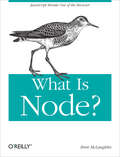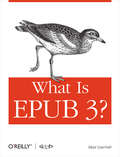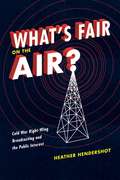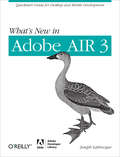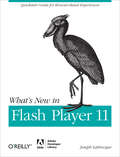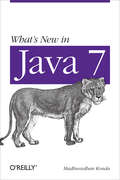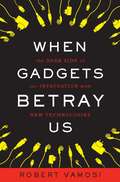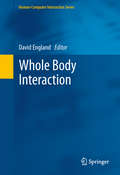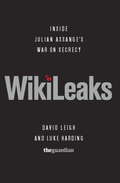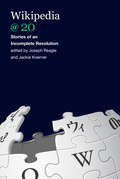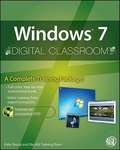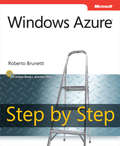- Table View
- List View
Wearable Monitoring Systems
by Annalisa Bonfiglio Danilo De RossiAs diverse as tomorrow's society constituent groups may be, they will share the common requirements that their life should become safer and healthier, offering higher levels of effectiveness, communication and personal freedom. The key common part to all potential solutions fulfilling these requirements is wearable embedded systems, with longer periods of autonomy, offering wider functionality, more communication possibilities and increased computational power. As electronic and information systems on the human body, their role is to collect relevant physiological information, and to interface between humans and local and/or global information systems. Within this context, there is an increasing need for applications in diverse fields, from health to rescue to sport and even remote activities in space, to have real-time access to vital signs and other behavioral parameters for personalized healthcare, rescue operation planning, etc. This book's coverage will span all scientific and technological areas that define wearable monitoring systems, including sensors, signal processing, energy, system integration, communications, and user interfaces. Six case studies will be used to illustrate the principles and practices introduced.
Web Commerce Security
by Ronald L. Krutz Hadi NahariA top-level security guru for both eBay and PayPal and a best-selling information systems security author show how to design and develop secure Web commerce systems.Whether it's online banking or ordering merchandise using your cell phone, the world of online commerce requires a high degree of security to protect you during transactions. This book not only explores all critical security issues associated with both e-commerce and mobile commerce (m-commerce), it is also a technical manual for how to create a secure system. Covering all the technical bases, this book provides the detail that developers, system architects, and system integrators need to design and implement secure, user-friendly, online commerce systems.Co-authored by Hadi Nahari, one of the world's most renowned experts in Web commerce security; he is currently the Principal Security, Mobile and DevicesArchitect at eBay, focusing on the architecture and implementation of eBay and PayPal mobileCo-authored by Dr. Ronald Krutz; information system security lecturer and co-author of the best-selling Wiley CISSP Prep Guide SeriesShows how to architect and implement user-friendly security for e-commerce and especially, mobile commerceCovers the fundamentals of designing infrastructures with high availability, large transactional capacity, and scalabilityIncludes topics such as understanding payment technologies and how to identify weak security, and how to augment it.Get the essential information you need on Web commerce security--as well as actual design techniques--in this expert guide.
Web Design in Easy Steps
by Sean McmanusThere are millions of websites on the Internet, but most of them fail to make a lasting impression on readers and web surfers. Creating a site that is both appealing and financially remunerative can seem challenging, but this invaluable tool makes the process both simple and fun. As with every book in the popular series of computer books, this one walks readers through every step of the process. From design planning to search engine promotion, each step of the process is thoroughly explained in clear, jargon-free English. Full-color graphics, including numerous screenshots, add further support and clarification. Written by the designer of the website for the In Easy Steps series, this book contains all the information needed to create a website that looks good and makes money. This updated edition adds more value by covering HTML and CSS.
Web Design with HTML and CSS Digital Classroom
by Jennifer Smith Agi Creative Team Jeremy Osborn"An invaluable full-color training package for Web design Web design consists of using multiple software tools and codes-such as Dreamweaver, Flash, Silverlight, Illustrator, Photoshop, HTML, and CSS, among others-to craft a unique, robust, and interactive websites. This book teaches you how to effectively use all the major tools involved in web design to create a site that is both attractive and functional. You'll go beyond the basics to learn best practices of good web design so you can go from the drawing board to a successful site. Combining full-color, step-by-step instructions with lesson files and video training from web experts is like having your own personal instructor guiding you through each lesson-but you work at your own pace! Discusses properties of good web design and best practices for building a site that is both attractive and functional Offers clear instruction that makes learning complicated tasks less intimidating Demonstrates how to approach site design concept creation and bring a vision from the drawing board through to full and dazzling operability Combines a full color step-by-step instructional book along with lesson files and video training from web design experts This training package takes you beyond the basics in a series of easy-to-absorb, five-minute lessons. "
Web Development Bibliography
by Safari Books Online Content TeamToday's web applications are powerful and interactive that have to work equally well on a variety of web browsers on desktop computers, tablets, and smartphones. Many of the most popular web applications are able to do all of this while scaling to handle thousands of requests per second from all over the globe. It's a good thing that the list of technologies and tools for creating these web applications has also grown rapidly to enable web developers to build them. This guide allows you to tap into books and videos that cover the major technologies required to build Web apps: from JavaScript and HTML5 and CSS3 to Java and PHP to jQuery, Node.js and more.
Web Security, Privacy & Commerce: Security for Users, Administrators and ISPs
by Simson Garfinkel Gene SpaffordSince the first edition of this classic reference was published, World Wide Web use has exploded and e-commerce has become a daily part of business and personal life. As Web use has grown, so have the threats to our security and privacy--from credit card fraud to routine invasions of privacy by marketers to web site defacements to attacks that shut down popular web sites.Web Security, Privacy & Commerce goes behind the headlines, examines the major security risks facing us today, and explains how we can minimize them. It describes risks for Windows and Unix, Microsoft Internet Explorer and Netscape Navigator, and a wide range of current programs and products. In vast detail, the book covers:Web technology--The technological underpinnings of the modern Internet and the cryptographic foundations of e-commerce are discussed, along with SSL (the Secure Sockets Layer), the significance of the PKI (Public Key Infrastructure), and digital identification, including passwords, digital signatures, and biometrics.Web privacy and security for users--Learn the real risks to user privacy, including cookies, log files, identity theft, spam, web logs, and web bugs, and the most common risk, users' own willingness to provide e-commerce sites with personal information. Hostile mobile code in plug-ins, ActiveX controls, Java applets, and JavaScript, Flash, and Shockwave programs are also covered.Web server security--Administrators and service providers discover how to secure their systems and web services. Topics include CGI, PHP, SSL certificates, law enforcement issues, and more.Web content security--Zero in on web publishing issues for content providers, including intellectual property, copyright and trademark issues, P3P and privacy policies, digital payments, client-side digital signatures, code signing, pornography filtering and PICS, and other controls on web content.Nearly double the size of the first edition, this completely updated volume is destined to be the definitive reference on Web security risks and the techniques and technologies you can use to protect your privacy, your organization, your system, and your network.
Web Standards
by Leslie F. SikosWeb Standards: Mastering HTML5, CSS3, and XML provides solutions to the most common web design problems, and gives you a deep understanding of web standards and how they can be implemented to improve your web sites. You will learn how to develop fully standards-compliant, mobile-friendly, and search engine-optimized web sites that are robust, fast, and easy to update while providing excellent user experience and interoperability. The book covers all major web standards for markup, style sheets, web typography, web syndication, semantic annotations, and accessibility. This edition has been fully updated with the latest in web standards, including the finalized HTML5 vocabulary and the full list of CSS3 properties. Web Standards: Mastering HTML5, CSS3, and XML is also a comprehensive guide to current and future standards for the World Wide Web, demonstrating the implementation of new technologies to address the constantly growing user expectations. Web Standards: Mastering HTML5, CSS3, and XML presents step-by-step guides based on solid design principles and best practices, and shows the most common web development tools and web design frameworks. You will master HTML5 and its XML serialization, XHTML5, the new structuring and multimedia elements, the most important HTML5 APIs, and understand the standardization process of HTML 5. 1, HTML 5. 2, and future HTML5 versions.
Web-Based and Traditional Outsourcing
by Vivek Sharma Varun Sharma K.S. RajasekaranIn today's increasingly competitive business environment, organizations must be able to adapt to the ever-changing business landscape where traditional business concepts no longer ensure success. The future will be driven by value and competing ideas-creating an environment where old alignments and equations will be replaced by a global network of
Website Design and Development
by George PlumleyA helpful book-and-video package for building and maintaining a successful Web siteHow do you know that you've done everything possible to create a unique, enriching, and successful Web site, particularly when you're hiring others to do it? With Website Design and Development, you'll feel confident that you've exhausted every facet of building a Web site. The clever question-and-answer format walks you through easily overlooked details, acting as a virtual consultant. You'll get clear, easy-to-follow advice on everything from finding a host, design and layout, creating content, marketing, to staying secure. Each question features a rating as to how critical it is to the welfare of the site, allowing you to pick and choose where to spend your time and money, and the answers contain helpful illustrations as well as action points. In addition, your learning experience is further enhanced by the high-quality accompanying video.Contains professional advice for creating--and maintaining--a successful Web siteFeatures an accompanying video that offers additional examples, commentary, and advice for each question.Lists questions you should ask yourself or your web developer and then presents clear, concise answers as well as helpful checklistsRates each topic as to its importance in the grand scheme of your Web site so that you can determine how to spend your time and moneyWebsite Design and Development answers the essential questions that need to be asked before creating a Web site.
Wedding Photojournalism: The Business of Aesthetics
by Paul D Van HoyThis valuable resource focuses on what professional wedding photographers need to do to stay competitive and continue winning new assignments, despite an array of challenges. Though wedding budgets are often subject to cuts, photographers will learn how to finesse their operations, improve their marketing, and convert client contacts into reliable job streams. By running a lean business with few excess costs, this step-by-step guide lays out how wedding photographers can draw attention to their studio, generate demand, and create a brand that complements and promotes their unique vision. Included are tips for improving search-engine optimization, marketing, pricing, packaging, and contracts to enable aspiring and experienced professionals alike to follow their passions to success.
Welcome to Microsoft Office 2010
by Jill Murphy"Welcome to Microsoft Office 2010" is a fun, easy way for beginners to learn how to use Office 2010 software. The book provides a basic understanding of the software applications typically required for both home and business, including Word, Excel, PowerPoint and Access. Learning is reinforced with plenty of illustrations and practical, hands-on projects and exercises. Specific, step-by-step instructions work well in both instructor-led and self-paced
What Color Is Your Parachute? Guide to Job-Hunting Online (Sixth Edition): Blogging, Career Sites, Gateways, Getting Interviews, Job Boards, Job Search Engines, Personal Websites, Posting Resumes, Research Sites, Social Networking
by Richard Nelson Bolles Mark Emery BollesBefore you start your Internet job-hunt, there are some things that you must know, like: * Why are job sites like Monster and CareerBuilder so stunningly ineffective? * What can you do to make sure your resumes survive the elimination process? * How do you find the information that search engines like Google can't? * How can you tell the difference between a genuinely helpful job board, and a website designed only to collect resumes? * When are hobby forums more helpful than business networking sites? * When is the Internet not helpful when job-hunting? * What is the fatal flaw of all social networking sites? The Guide to Job-Hunting Online, 6th Edition, not only answers these questions and many more, but shows you how to comprehensively and effectively use the Internet for all aspects of your job-hunt. This companion to What Color Is Your Parachute?, the best-selling job-hunting book in the world, has been completely rewritten for our changing times and includes hundreds of updated website recommendations and descriptions. The Guide to Job-Hunting Online shows you how to quickly find the data that will be most helpful to you, how to identify and research the places where you will most enjoy working, how to leverage the power of social networking sites, and how to use your Internet time most effectively, avoiding the common pitfalls and setting you up for success.
What Is HTML5?
by Brett McLaughlinHTML5: Everyone’s using it, nobody knows what it is. I realize that sounds more like a line out of an existential movie — maybe Waiting for Godot or a screenplay by Sartre — than a statement about HTML5. But it’s really the truth: most of the people using HTML5 are treating it as HTML4+, or even worse, HTML4 (and some stuff they don’t use). The result? A real delay in the paradigm shift that HTML5 is almost certain to bring. It’s certainly not time to look away, because by the time you look back, you may have missed something really important: a subtle but important transition centered around HTML5.
What Is Node?
by Brett McLaughlinNode.js. It’s the latest in a long line of “Are you cool enough to use me?” programming languages, APIs, and toolkits. In that sense, it lands squarely in the tradition of Rails, and Ajax, and Hadoop, and even to some degree iPhone programming and HTML5.Dig a little deeper, and you’ll hear that Node.js (or, as it’s more briefly called by many, simply “Node”) is a server-side solution for JavaScript, and in particular, for receiving and responding to HTTP requests. If that doesn’t completely boggle your mind, by the time the conversation heats up with discussion of ports, sockets, and threads, you’ll tend to glaze over. Is this really JavaScript? In fact, why in the world would anyone want to run JavaScript outside of a browser, let alone the server?The good news is that you’re hearing (and thinking) about the right things. Node really is concerned with network programming and server-side request/response processing. The bad news is that like Rails, Ajax, and Hadoop before it, there’s precious little clear information available. There will be, in time — as there now is for these other “cool” frameworks that have matured — but why wait for a book or tutorial when you might be able to use Node today, and dramatically improve the maintainability.
What is EPUB 3?
by Matt GarrishThis book discusses the exciting new format that is set to unleash a content revolution in the publishing world. Laden with features the printed page could never offer--such as embedded multimedia and scripted interactivity--EPUB 3 will forever change what a book can be. This article walks you through the format and puts it in its place in the digital landscape, explaining why EPUB 3 is set to become the new global standard for ebooks as it also becomes the new accessible standard for ebooks.
What's Fair on the Air?: Cold War Right-Wing Broadcasting and the Public Interest
by Heather HendershotThe rise of right-wing broadcasting during the Cold War has been mostly forgotten today. But in the 1950s and ’60s you could turn on your radio any time of the day and listen to diatribes against communism, civil rights, the United Nations, fluoridation, federal income tax, Social Security, or JFK, as well as hosannas praising Barry Goldwater and Jesus Christ. Half a century before the rise of Rush Limbaugh and Glenn Beck, these broadcasters bucked the FCC’s public interest mandate and created an alternate universe of right-wing political coverage, anticommunist sermons, and pro-business bluster. A lively look back at this formative era, What’s Fair on the Air? charts the rise and fall of four of the most prominent right-wing broadcasters: H. L. Hunt, Dan Smoot, Carl McIntire, and Billy James Hargis. By the 1970s, all four had been hamstrung by the Internal Revenue Service, the FCC’s Fairness Doctrine, and the rise of a more effective conservative movement. But before losing their battle for the airwaves, Heather Hendershot reveals, they purveyed ideological notions that would eventually triumph, creating a potent brew of religion, politics, and dedication to free-market economics that paved the way for the rise of Ronald Reagan, the Moral Majority, Fox News, and the Tea Party.
What's New in Adobe AIR 3
by Joseph LabrecqueThis book will present you with a full rundown of all the new features in the upcoming AIR 3.0 runtime. Along with each feature, if applicable, will be a demonstration of how to employ the new feature. There's also be a short introduction to AIR and a chapter dedicated to providing you with additional resources.
What's New in Flash Player 11
by Joseph LabrecqueThis book will present you with a full rundown of all the new features in the upcoming Flash Player 11 runtime. Along with each feature, if applicable, will be a demonstration of how to employ the new feature. There's also be a short introduction to Flash Player and a chapter dedicated to providing you with additional resources.
What's New in Java 7
by Madhusudhan KondaJava 7 has a number of features that will please developers. Madhusudhan Konda provides an overview of these, including strings in switch statements, multi-catch exception handling, try-with-resource statements, the new File System API, extensions of the JVM, support for dynamically-typed languages, and the fork and join framework for task parallelism.
When Gadgets Betray Us: The Dark Side of Our Infatuation With New Technologies
by Robert VamosiWriting in plain language for general readers, Vamosi, a computer security analyst and a contributing editor at PCWorld, explains what we're really signing up for when we log in and reveals the secret lives of our electronic devices, offering a commonsense approach for protecting ourselves. The book is about hardware hacking and new kinds of identity fraud: how our mobile phone conversations can be intercepted, how our credit cards and driver's licenses can be copied at a distance. The author travels from the streets of New York and LA to Johannesburg and Berlin, to talk to people who have experienced firsthand how gadgets can betray us and to examine the effects of technology in the Third World. He recommends the addition of basic authentication and strong encryption to most hardware to reduce the vulnerabilities described in the book, but notes that hardware manufacturers have so far shown little interest in securing their gadgets. Annotation ©2011 Book News, Inc. , Portland, OR (booknews. com)
Whole Body Interaction
by David EnglandWhole Body Interaction is "The integrated capture and processing of human signals from physical, physiological, cognitive and emotional sources to generate feedback to those sources for interaction in a digital environment" (England 2009). Whole Body Interaction looks at the challenges of Whole Body Interaction from the perspectives of design, engineering and research methods. How do we take physical motion, cognition, physiology, emotion and social context to push boundaries of Human Computer Interaction to involve the complete set of human capabilities? Through the use of various applications the authors attempt to answer this question and set a research agenda for future work. Aimed at students and researchers who are looking for new project ideas or to extend their existing work with new dimensions of interaction.
WikiLeaks: Inside Julian Assange's War on Secrecy
by David Leigh Luke HardingA team of journalists with unparalleled inside access provides the first full, in-depth account of WikiLeaks, its founder Julian Assange, and the ethical, legal, and political controversies it has both uncovered and provoked.
Wikipedia @ 20: Stories of an Incomplete Revolution
by Joseph Reagle and Jackie KoernerWikipedia's first twenty years: how what began as an experiment in collaboration became the world's most popular reference work.We have been looking things up in Wikipedia for twenty years. What began almost by accident--a wiki attached to an nascent online encyclopedia--has become the world's most popular reference work. Regarded at first as the scholarly equivalent of a Big Mac, Wikipedia is now known for its reliable sourcing and as a bastion of (mostly) reasoned interaction. How has Wikipedia, built on a model of radical collaboration, remained true to its original mission of "free access to the sum of all human knowledge" when other tech phenomena have devolved into advertising platforms? In this book, scholars, activists, and volunteers reflect on Wikipedia's first twenty years, revealing connections across disciplines and borders, languages and data, the professional and personal.
Windows 7 Digital Classroom
by Agi Creative Team Kate ShoupBring the classroom to your home with this training DVD and full-color instructional book!Windows 7 is the much-anticipated new operating system from Microsoft and is packed with new features and capabilities. With this book-and-DVD combination, you can learn essential skills and explore all the exciting new possibilities that Windows 7 has to offer. Fifteen self-paced lessons allow you to move at a speed that is comfortable for your learning style. Step-by-step instructions, lesson files, and video tutorials complement each topic covered.You'll investigate the new interface and functionality and learn how to customize settings, work with Internet Explorer, and maintain and troubleshoot issues. Packed with helpful information, this book encourages you to confidently get the most out of the new features of Windows 7.Serves as your own personal instructor, providing you with a valuable DVD-and-book combination that takes you from the basics through intermediate-level topicsAllows you to learn the exciting new features of Windows 7 at your own pace, with video tutorials that complement the topics covered in the book Demonstrates how to customize settings, work with Internet Explorer, and maintain and troubleshoot issuesEncourages you to get the most out of everything Windows 7 has to offerWindows 7 Digital Classroom is like having your own personal instructor guiding you through each lesson, while you work at your own pace.
Windows Azure™ Step by Step
by Roberto BrunettiYour hands-on, step-by-step guide to the programming fundamentals for Windows AzureTM Teach yourself how to build and host scalable applications in the cloud using Windows Azure--one step at a time. Ideal for those with basic programming skills, this tutorial provides practical, learn-by-doing exercises for working with the core services and features of the Windows Azure platform. Discover how to: Extend your existing skills to the cloud development model Build a simple web role application and deploy it to the cloud Create a worker role project to perform backend processes Store persistent data with Windows Azure Storage Develop a scalable database application in the cloud using Microsoft SQL AzureTM Connect several cloud-based applications with Windows Azure AppFabric Design a multitiered solution that can scale to meet user demand
